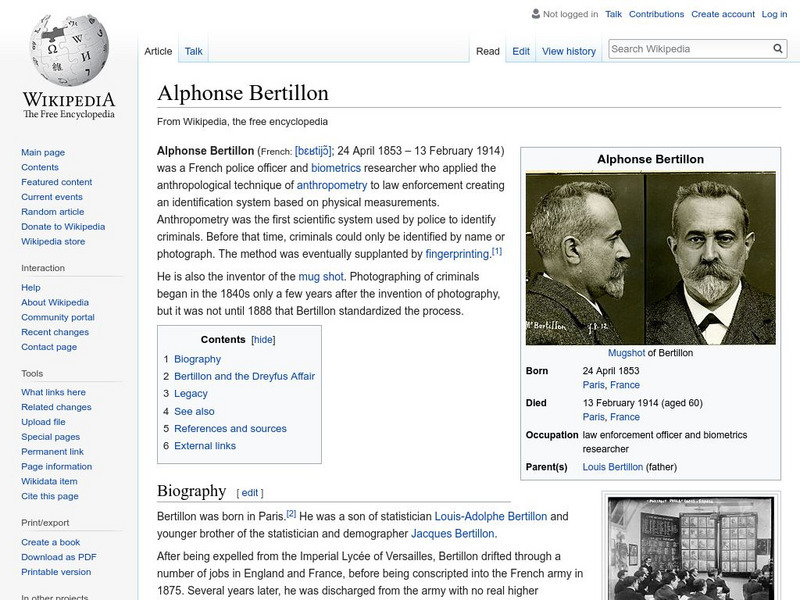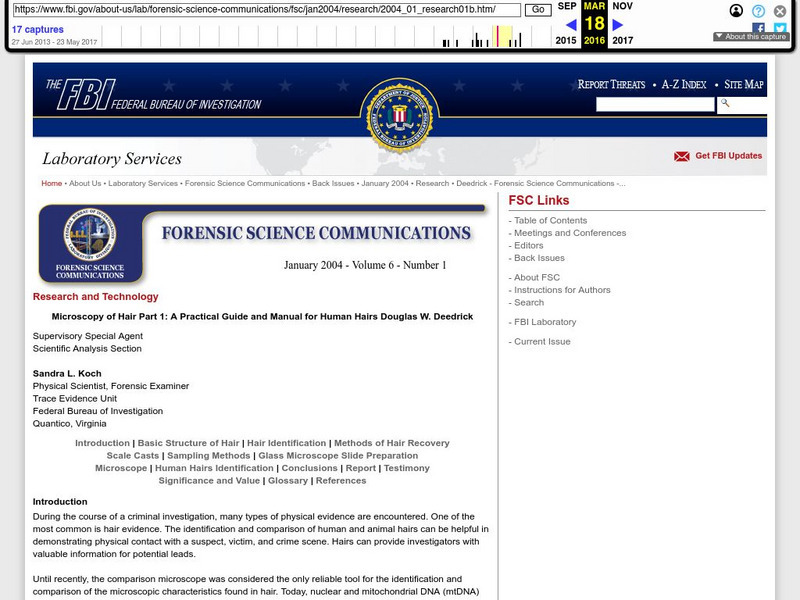Towson University
The Wildlife Forensics Lab
Can science put an end to the poaching of endangered species? Show your young forensic experts how biotechnology can help save wildlife through an exciting electrophoresis lab. Grouped pupils analyze shark DNA to determine if it came...
Towson University
Case of the Crown Jewels
Can your biology class crack the Case of the Crown Jewels? Junior forensics experts try their hands at DNA restriction analysis in an exciting lab activity. The lesson introduces the concept of restriction analysis, teaches pipetting and...
Curated OER
More Basic Biotechnology Tools, Sorting & Copying DNA
You can use these slides to explain the many complicated steps of the Polymerase chain reaction. The diagnostic and forensic uses of gel electrophoresis are detailed. This PowerPoint could be used to communicate facts, and also to...
Curated OER
More Basic Biotechnology Tools
You can use these slides to explain the many complicated steps of the Polymerase Chain Reaction. The diagnostic and forensic uses of gel electrophoresis are detailed. This PowerPoint could be used to communicate facts, or to prompt...
Curated OER
Benefits of Biotechnology
Various aspects about the impact of biotechnology in our everyday lives, and many examples of its application are given in these slides. Designed with multiple fonts, the style should be appealing to youth.
Science Struck
Science Struck: Locard's Exchange Principle in Forensic Science
'This resource describes some of the history of forensic science and what Locard's Exchange Principle is and how it is applied. Discusses the different types of trace evidence that investigators look for and some drawbacks of Locard's...
Oak Ridge National Laboratory
Oak Ridge National Laboratory: Dna Forensics
A concise explanation of the use of DNA technologies in forensic identification from the Oak Ridge National Laboratory. Additional valuable resources are provided.
PBS
Pbs Learning Media: Forensics and Dna Profiling
Find out how DNA profilers analyze bits of tissue to identify human remains. From the NOVA: "Lost on Everest" Web site.
Wikimedia
Wikipedia: Alphonse Bertillon
On-line encyclopedia provides information pertaining to Alphonse Bertillon's life work and accomplishments, particularly in the area of forensic science.
PBS
Nova: Identifying Remains With Dna
Mitochondrial DNA has different properties than nuclear DNA which make it beneficial in certain forensic settings. Get the details on the ways mitochondrial DNA is being used in forensic science.
Federal Bureau of Investigation
Federal Bureau of Investigation: Practical Guide for Human Hairs
The FBI gives a detailed analysis of the human hair including how to use it as forensic evidence. Topics covered are hair structure, identification, and methods of hair recovery. Labeled diagrams and electron photomicrographs enhance the...
New York University
Mug Shots and Evidence: Alphonse Bertillon
Resource highlights Alphonse Bertillon's contribution to forensic science with the standardized mug shot.
BiologyWise
Biology Wise: Why Is Dna Important
Explains what DNA is and how much information lies stored in its structure, and discusses the many applications of the science of DNA in agriculture, forensic science, human genetics, etc.
PBS
Pbs Learning Media: Dna Fingerprint Photos
These photographs supplied by Genelex Corporation depict actual DNA fingerprints and show the types of information that can be gleaned from them.
Science Struck
Science Struck: A Quick Guide to the Different Types of Archaeology
The field of archaeology has been specializations that investigate the past through many different lenses, e.g., environmental relationships, landscape study, and aerial investigation. This resource describes many of these specialties.
PBS
Pbs Learning Media: How Dna Evidence Works
In this article by An Meeker-O'Connell, discover how DNA evidence is processed before it goes to court.
PBS
Pbs Learning Media: Dna on the Witness Stand
Dr. Eric Lander of the Human Genome Project explains the use of DNA as forensic evidence. He describes the process and need for standards in testing laboratories and discusses the use of DNA evidence as a human rights tool.
BiologyWise
Biology Wise: History of Dna Fingerprinting
Discusses the scientists who made discoveries about DNA and those who invented and worked on DNA fingerprinting, and some of the criminal cases that were resolved or thrown out through the use of DNA evidence. (Warning: Some of these...
Other
Early Fingerprinting Pioneers
This resource takes a look at some of the early fingerprinting pioneers such as Marcello Malpighi, William Herschel, Alphonse Bertillon and many more.
American Academy of Family Physicians
Family doctor.org: Autopsy: Questions and Answers
Article provides questions and answers to this procedure to educate the general public.
WebMD
Web Md: Autopsies: When Are They Done?
Why is an autopsy done? How is it done? What are the risks? Discover the answers to these questions and many more as you peruse this site.
BiologyWise
Biology Wise: Uses of Dna Fingerprinting
Explains what DNA profiling is and describes some of the many ways it is used.
Other popular searches
- Forensic Science Powerpoint
- Forensic Science Project
- Forensic Science Blood Type
- Vocabulary Forensic Science
- Forensic Science Lab
- Forensic Science Power Point
- Forensic Science Activities
- Forensic Science Fingerprint
- History of Forensic Science
- Forensic Science Entomology
- Forensic Science Archaeology
- Forensic Science Archeology












